According to the latest data, there are about 62.2 million people employed through staffing agencies. After the COVID-19 outbreak, the market experienced the largest rise of almost 40%, as it was able to fill the emerging skill gaps. However, in 2023, growth slowed down. That is why, today, agencies need to innovate and adapt to sustain the business.
In this article, we’ll look at the main staffing industry trends that will determine the sector’s future. You’ll check the state of the market, employees, and challenges that agencies are currently working with. So, let’s get started!
Before you get into the full list, here are the most notable staffing industry statistics to review:
In 2024, the staffing industry’s revenue worldwide was $626 billion. Despite a 12.44% decline in income in 2020 due to the COVID-19 outbreak, the market continues to grow. Based on SIA forecasts, the global staffing industry will rise about 6% annually.
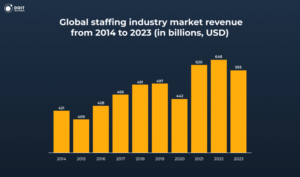
The United States generates over a quarter of the sector’s revenue. Today, there are 26,000 staffing and recruiting companies in the US alone, operating around 49,000 offices. Their earnings hit $159.1 billion. Forecasts say the US staffing market will grow 1.3% in 2024 and 2.1% in 2025.
Besides leading by revenue, the United States has the highest interest rate in staffing. The top 5 also include Kenya, Canada, South Africa, and the Philippines.
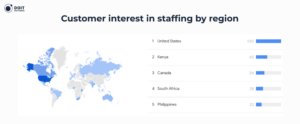
US staffing companies hired around 14.6 million temporary and contract workers in 2022. The peak over the past 10 years was in 2018, with 16.8 million people hired. According to this indicator, the US is second after China, with 21 million staffing workers on average per year.
Here is the number of temporary and contract staffing employment in the US in recent years:
2016
14.5
-
2017
15.5
↑ 6.9%
2018
16.8
↑ 8.4%
2019
16
↓ 4.76%
2020
13.6
↓ 15%
2021
14.1
↑ 3.68%
2022
14.6
↑ 3.55%
In total, the staffing industry employs only 1.92% of the US nonfarm labor force. For comparison, the staffing agency penetration rate in Europe is 1.37%, and in the Asia-Pacific region, it is 2.17%. The highest value ( >3%) is in the Netherlands and the UK.
Now, let’s look at the demographics of employees working through staffing agencies. In this section, we will review their occupations, average rates in the US, and the staffing industry trends by sector.
Today, around 40% of staffing specialists work in high-skilled fields. Among them, 21% are in professional management, 11% in engineering, IT, and science, and 8% in healthcare. Such roles often require specialized education and are paid above average.
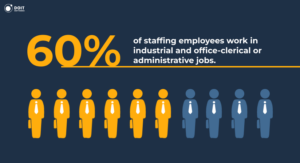
Also, the remaining 60% work in industrial and office-clerical or administrative jobs. Here are some insights:
Let’s analyze the staffing data in detail by job demand and salary.
Almost 3 million temporary and contract employees work for US staffing companies during an average week. According to the Bureau of Labor Statistics, as of May 2023, there were 2,964,020 temporary employment positions.
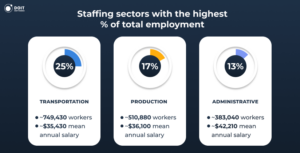
Transportation and material moving occupations accounted for 25.28% of the total. The next most popular were production (17.24%) and office and administrative support roles (12.92%).
Here is a breakdown of staffing industry trends by occupation employment:
Transportation and material moving
749,430
25.28%
$17.03
$35,430
Production
510,880
17.24%
$17.36
$36,100
Office and administrative support
383,040
12.92%
$20.29
$42,210
Business and financial operations
224,950
7.59%
$37.86
$78,750
Healthcare practitioners and technical
177,710
6.00%
$47.25
$98,270
Computer and mathematical
138,350
4.67%
$48.87
$101,660
Building and grounds cleaning
118,500
4.00%
$16.65
$34,630
Construction and extraction
108,340
3.66%
$21.74
$45,230
Healthcare support
102,020
3.44%
$20.87
$43,410
Sales
62,270
2.10%
$27.55
$57,300
Food preparation and serving
60,530
2.04%
$17.06
$35,470
Educational instruction
59,870
2.02%
$19.41
$40,370
Management
58,160
1.96%
$62.50
$130,000
Installation, maintenance, and repair
54,980
1.85%
$22.40
$46,590
Architecture and engineering
33,690
1.14%
$47.56
$98,930
Arts, design, entertainment, sports, and media
25,360
0.86%
$41.12
$85,520
Protective service
25,350
0.86%
$19.76
$41,090
Personal care
22,640
0.76%
$17.27
$35,930
Life, physical, and social science
21,500
0.73%
$32.25
$67,080
Community and social service
12,250
0.41%
$27.78
$57,770
All occupations
2,964,020
100%
$24.73
$51,450
The highest-cost expert group hired through staffing companies is management, with an annual average salary of $130,000. Here, chief executives receive over $245,380 per year, architectural and engineering managers – $190,390, and PR managers – $183,650.
The second high-paid sector is computer and mathematical roles, with an average salary of $101,660 per year. So, if you want to hire information research scientists, expect to pay $158,940 per year, database architects – $152,840, and software developers – $140,470.
On average, the IT staffing industry pays $131,470 annually/per employee in the US. Here is a detailed overview.
Computer programmers
Create, modify, and test the code and scripts that allow computer applications to run.
$59.61
$123,990
Software developers
Research, design, and develop computer and network software or specialized utility programs.
$67.54
$140,470
Software QA analysts and testers
Develop and execute software tests to identify software problems and their causes.
$49.59
$103,150
Web developers
Develop and implement websites, web applications, app databases, and interactive web interfaces.
$64.24
$133,630
Web and digital interface designers
Design digital user interfaces or websites.
$58.77
$122,240
Now, let’s move on to the staffing industry trends and goals agencies currently face. In this section, we’ll focus on hiring practices, technologies, and investments that will impact staffing’s future.
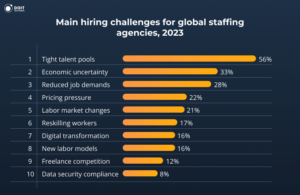
The SIA‘s staffing report shows that, on average, 1 in 2 agencies faces the reluctance of candidates to take extensive test tasks. Moreover, about 33% complain about potential cheating in the interview process.
As these issues grow, research into candidate assessment technologies will increase 1.7x over the next two years. 40% of the market currently uses these techniques and over two-thirds plan to do so.
Today, the staffing market uses the following stages of candidate selection:
Also, some of the leading staffing companies plan to adopt AI-driven assessments and transparent evaluation practices within the next 2 years:
The SIA notes that it is reasonable to assume these best practices are a big contributor to the candidate search success. Besides these practices, many staffing agencies are leveraging jobs API to streamline the job posting process and automate resume screening. Also, they use the technology to facilitate real-time updates between candidate applications and applicant tracking systems (ATS).
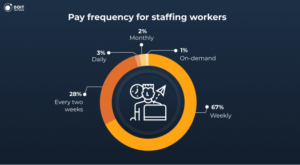
Weekly payments (67%) dominate the US staffing market, while another 28% of workers get bi-weekly compensation. Only 3% benefit from daily billing, 2% – monthly, and 1% – on an on-demand basis.
At the same time, according to Gartner, 20% of hourly workers want to receive wages in this way. And the EWA report claims about 90% of staff want their employer to remove the usual weekly or monthly pay cycles.
The SIA staffing industry analysis indicates that vendors with daily or on-demand rates achieve better staff retention and productivity. 77% of workers report less stress with “Earned Wage Access.” Also, 72% of them have more control over their finances. Thus, more flexible payment methods are one of the new staffing industry trends.
In recent years, staffing companies are increasingly offering extra services beyond the main one. For example, Addeco, one of the market leaders, received 76% of its revenue from staffing in 2022. The rest came from talent solutions (LHH) – 8%, and HR consulting – 16%.
The most common complementary services among staffing providers are the following:
These services are most often seen among IT staffing trends. With the growth of remote work, companies began to offer staff augmentation with all related administrative needs. They handle work equipment, salaries, taxes, legal support, etc.

Only 9% of fast-growing companies don’t invest in job boards. Overall, expenses increased by 43% compared to 2022. In 2023, healthcare staffing companies spent the most on job boards (about $288,591 per year), while office and clerical agencies spent the least ($133,728).
However, despite the growth, companies plan to reduce their spending on job boards by an average of 8% in 2024.
Among the most popular digital transformation expenses are applicant tracking systems, job boards, recruiting, data, and timesheet automation.
73% of staffing executives say that recruitment automation will transform the market. Currently, 68% of companies have already automated background checks. Staffing industry trends for automation also cover the following:
Moreover, around 33% of staffing agencies plan to invest in resume screening automation in 2024. For this and other reasons mentioned above, 48% of agencies already use AI, and 24.8% plan to do so by the end of 2024.
Executives point out that in 2024, it became more difficult to find specialists. The search period for logistics and industrial workers increased by at least 2 days compared to 2023. Also, there was a significant increase in the search for engineers and designers – 11 days longer.
Here is a detailed comparison of the average time to fill a job by industry in 2023 and 2024:
Industrial & logistic
9.4 days
11.9 days
Office, clerical & administrative
13.3 days
19.4 days
Healthcare
17.4 days
20.5 days
IT
22.5 days
24.3 days
Finance & accounting
19.8 days
24.1 days
Engineering and design
19.6 days
30.9 days
Also, the fill rate (% of filled job orders) was 62% in 2023. Looking ahead to 2024, the situation will decline, with staffing agencies only able to fill every second job order.
The average cost per hire will also increase from $1,813 to $2,143. The most expensive hiring will be in design and engineering – $3,757 per hire. And the biggest price drop will occur in IT, from $4,138 in 2023 to $3,002 in 2024.
That wraps up our analysis of staffing industry trends. After rapid growth, staffing will pick up a sustainable trajectory in the next few years. New AI solutions and complementary services will boost the hiring rate and revenue in the industry. Agencies are already taking advantage by increasing budgets for new sourcing practices. In the future, their offerings will be more flexible, from services to payment.
Today, there are about 26,000 US staffing companies operating from 49,000 offices.
Despite an 8% decline since 2022, forecasts say the staffing industry will grow by 6% annually.
The global average cost per hire is $2,143 in 2024. However, this varies by sector and location. For example, in design and engineering, it is $3,757 per employee. Some staffing agencies have a 0% recruiting cost and add interest on workers’ salaries.
Almost all industries use staffing services. The most prominent examples include IBM, Microsoft, Google, Amazon, Walmart, and many others.










